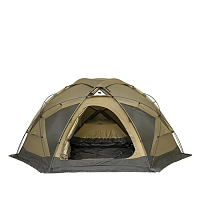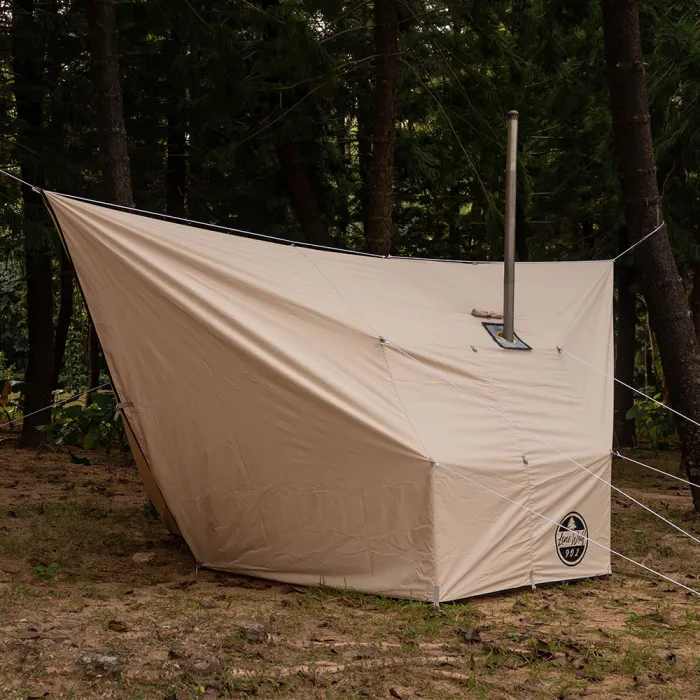Cart
Loadding...
Building a Tarp Shelter with Wood Stove: Step-by-Step Guide
Mar 25, 2024
Introduction:
When it comes to camping in the great outdoors, having a reliable shelter is essential for a comfortable and enjoyable experience. One versatile option is a tarp shelter with a wood stove, which provides both protection from the elements and warmth on chilly nights. In this step-by-step guide, we will walk you through the process of building a tarp shelter with a wood stove. From selecting the right materials to setting up the shelter, this guide will help you create a cozy and functional camping setup for your outdoor adventures.
1. Choosing the Right Tarp:
The first step in building a tarp shelter is selecting the right tarp. Look for a durable and waterproof tarp made from high-quality materials. Consider the size of the tarp based on the number of occupants and the desired covered area. Ensure that the tarp has reinforced grommets or loops along the edges for easy attachment and secure setup.
2. Finding a Suitable Location:
When choosing a location for your tarp shelter, look for a flat and level area that is clear of debris and potential hazards. Consider the direction of prevailing winds and position the shelter in a way that provides optimal protection and ventilation. Also, ensure that you are complying with any camping regulations or restrictions in the area.
3. Setting up the Tarp:
Start by laying the tarp flat on the ground in the desired location. Attach one corner of the tarp to a tree or a sturdy anchor point using a rope or carabiner. Then, stretch the tarp tightly and secure the remaining corners to anchor points using ropes or stakes. Ensure that the tarp is taut and properly tensioned to prevent sagging or flapping during windy conditions.
4. Building a Wood Stove Platform:
To safely use a wood stove inside your tarp shelter, it's important to create a sturdy and fire-resistant platform. Clear the ground of any flammable materials and create a base using rocks, bricks, or metal sheets. This platform will protect the ground from heat and prevent any accidental fires.
5. Installing the Wood Stove:
Place the wood stove on the prepared platform, ensuring that it is stable and level. Follow the manufacturer's instructions for setting up and operating the wood stove. Remember to leave enough space around the stove for safe movement and ventilation.
6. Ventilation and Safety Measures:
Proper ventilation is crucial when using a wood stove inside a tarp shelter. Create a vent by opening a small section of the tarp near the stove and securing it with ropes or stakes. This will allow for the escape of smoke and ensure a constant supply of fresh air. Additionally, keep a fire extinguisher and a carbon monoxide detector on hand for added safety.
7. Insulating and Sealing:
To enhance the heat retention and insulation of your tarp shelter, consider adding insulation layers. This can include insulating blankets, reflective tarps, or heat-resistant fabrics. Seal any gaps or openings in the tarp using duct tape or additional tarps to prevent drafts and heat loss.
8. Maintaining Fire Safety:
Always prioritize fire safety when using a wood stove inside a tarp shelter. Keep flammable materials away from the stove and maintain a safe distance between the tarp and the stovepipe to prevent accidental burns or fires. Regularly check for any signs of wear or damage in the tarp or stove setup and address them immediately.
Conclusion:
Building a tarp shelter with a wood stove can provide a cozy and functional camping setup for your outdoor adventures. By following this step-by-step guide, you can create a safe and comfortable environment that protects you from the elements and provides warmth during chilly nights. Remember to prioritize fire safety, proper ventilation, and insulation to ensure an enjoyable camping experience in your tarp shelter with a wood stove.
- Contact Us
-

About Pomoly
Pomoly is a leading camping brand specializing in hot tents and tent stoves. We are camping life explorer, Follow Page / Join Group, let's make camping enjoyful together!
Working Hours
Mon-Fri, 09:00 - 17:00

- Company Info
- NEWS
- About us
- Pomoly Name
- Leave-No-Trace
- Contact Now
- Facebook Group
- YouTube Learning
- Contact Us
- Topic Collections
- Policies & Terms
- Payment Policy
- Shipping Policy
- Return & Refund
- Privacy Policy
- Terms of Use
- Tax Policy
- Website Disclaimer
- Safety Disclaimer
- Warranty Policy
- Promotion Policy
- Pre-order Policy
- INTELLECTUAL PROPERTY RIGHTS
- Dealers Agreement And Terms
- Become Affiliate
- User Center
- Forget Password
- My Orders
- Tracking Order
- My Account
- Register
- Popular Searches
-
Tipi Tents Dome Tents Camping Tent Hammock Stove Camping Camping Pellet Stove Circle 6 Titanium Water TankDome X Locomotive 20 LEO 2 camping tent T-Brick 2.0 T1 2.0 tent stove Dweller wood stove Oroqen 2.0 Chimney Water Tank Lumberjack STOVEHUT Bromance 70 Tipi Pomoly Coupon Baker Oven Stove Titanium elbow Fire Pits Tent Stove titanium Stove Outdoor Pellet Stove
keebon pellet stove







